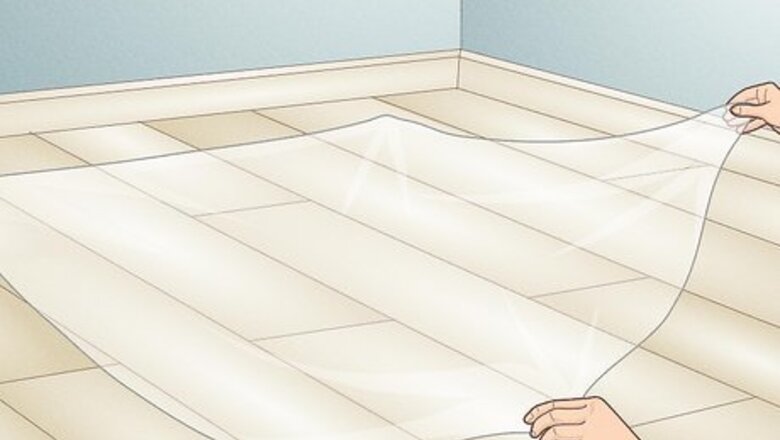
views
Cleaning and Taping a Ceiling Crack
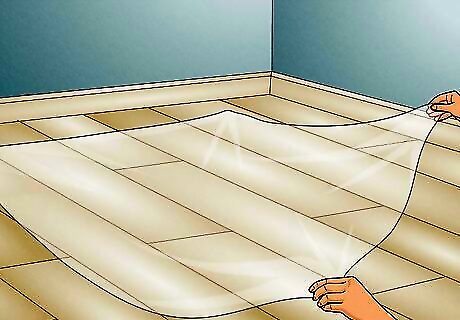
Put a sheet of plastic down under the crack. Since you’ll be loosening debris, applying mud, and generally making a mess while you’re repairing your ceiling crack, it’s smart to put down a large sheet of plastic beforehand. This way, once you’re done fixing the crack, you can just throw away the sheet of plastic and not have to worry about cleaning your floors. You can also remove cloth or fabric-covered furniture from the room since it will be difficult to clean paint and dust off of it.
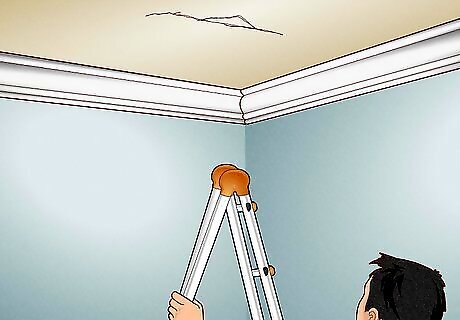
Set up an A-frame ladder. An A-frame will provide stability as you stand on it to reach your ceiling. Make sure that all four legs are stable and flat on the floor before you climb up, and avoid making sudden movements while you’re on the ladder. If your ladder has a fold-out section across from the top rung, you can use this to hold your tape, mud, and other repair supplies. A-frame ladders should be available for purchase at a local hardware store or home-supply store. A 6- or 8-foot (1.8-2.4 m) ladder will be most useful. If you have a low ceiling, you could feasibly use a step-ladder to fix the crack. The disadvantage, though, would be that you’ll be more precariously balanced on top of the step-ladder, and won’t have a way to set your patching materials within reach.
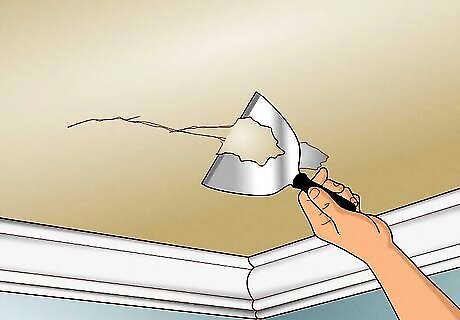
Scrape away loose material with a drywall knife. Position your 6-inch (15 cm) drywall knife at about a 15° angle against the ceiling near the crack. Slide it up under any loose, unattached pieces of drywall paper that are torn near the crack. Use the knife to slice these off, being careful not to damage the drywall beneath. Drywall knives will be available at any hardware store, paint shop, or home-supply store. Many sizes will be available, although the 6-inch (15 cm) is typically most effective.
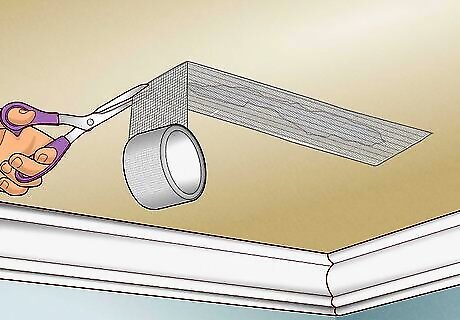
Apply mesh drywall tape directly over the crack. This tape will be adhesive, so it will stick firmly to your ceiling. Use long strips of tape to cover the entire crack. In fact, depending on the length of the crack, you may be able to cover the entire thing using one strip of tape. Position the tape so it’s centered directly over the crack, and press it firmly onto the ceiling. Do not apply more than a single layer of tape. Go over the tape a few times with a rolling pin or can to smooth it out. This is the same tape you use to connect the seams when you're installing drywall in the first place. It's available for purchase at a local hardware store or home-supply store. If the store has a variety of tapes, make sure to purchase an adhesive version.
Patching the Crack with 5-Minute Mud
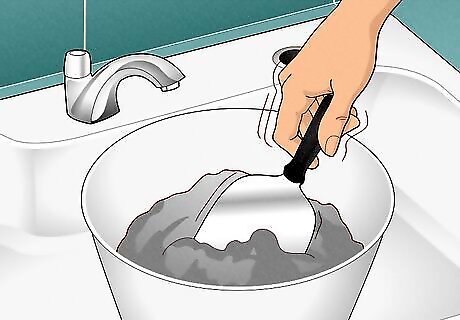
Mix 5-minute mud powered with water. Shake out about 1 lb (0.45 kg) worth of dry mud into a large plastic container. Add lukewarm water from your kitchen tap. While holding the container over your kitchen sink, use your putty knife to thoroughly mix the 5-minute mud. Continue adding water and mixing until the mud is roughly the consistency of mayonnaise. You can also secure the ceiling crack with joint compound. However, 5-minute mud will set more firmly than joint compound, and bolster the structural integrity of ceiling drywall. Five-minute mud will be available for purchase at your local hardware or home-supply store. You should only need a 3-lb (1.4 kg) bag of the sand. This should sell for between $5 USD and $7 USD. You can also use mud with a longer drying time, like 20-minute mud. Using mud with a longer drying time will give you more time to do the repair. As long as you do not mix the mud too watery, it will not fall on you, but you will need more time at the beginning to get the hang of plastering a ceiling. Spray the ceiling with a spray water bottle to help the mud adhere to the existing plaster. Mud does not stick to dust, oil, mold, too flat or loose surfaces.
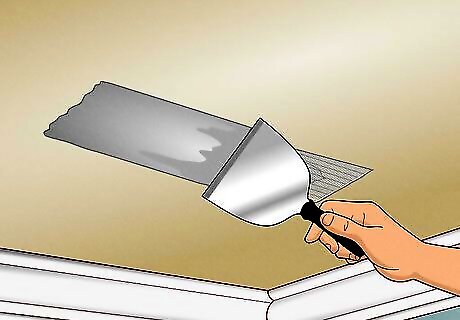
Apply a layer of the mud to your ceiling crack. Using the broad edge of your putty knife, apply a single, smooth layer of mud. Make sure to completely cover the mesh tape with mud. If you can, apply the mud in a single direction, parallel with the crack. Work quickly, since the mud will be dry in 5 minutes. Once you’ve applied the first layer, wait 30 minutes for the mud to fully dry. If the layer of mud looks uneven, use a wet sponge to smooth it out before it dries.
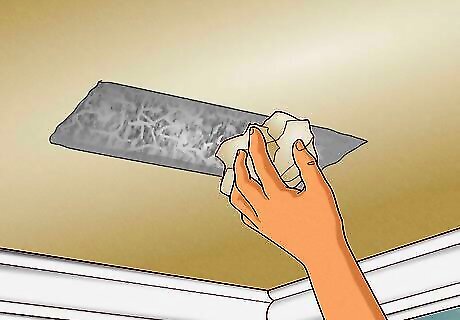
Add texture to the mud if your ceiling is texturized. Texturizing the mud will help it blend in with the rest of the ceiling. The best way to add texture to the mud depends on what kind of ceiling you have. If your ceiling has a swirl texture, use a soft paintbrush to recreate the pattern in the mud. If your ceiling has a knock-down texture, press a firm, wet piece of paper into the mud to replicate the texture. If your ceiling has a popcorn texture, spray over the mud with a popcorn ceiling patch spray.
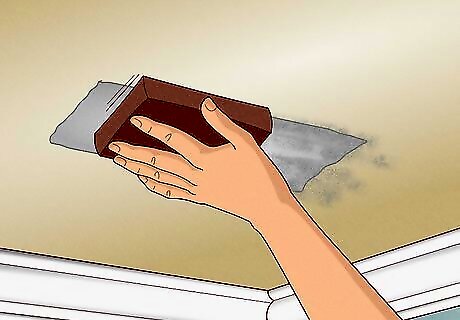
Sand the first layer of mud once it's dried. Sanding the mud in between layers will help make the final result look smoother and more professional. Use a sanding sponge to gently sand any rough patches on the mud, working in a back-and-forth motion.
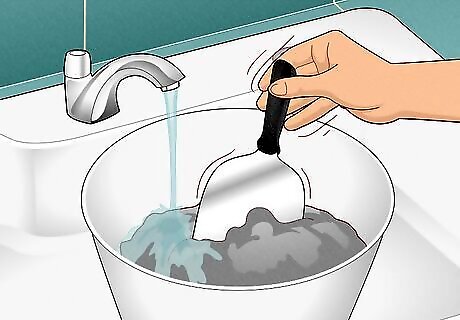
Mix a second batch of 5-minute mud. The second coat should be thinner than the first, so be sure to add more water from your kitchen tap to the same amount of sand. The thinner coat will cover any cracks or lumps present in the first coat of mud. Mix this batch until it’s roughly the consistency of sour cream. Use the corners and edge of your putty knife to scrape out any pockets of dry sand from the corners or edges of the plastic mixing container.
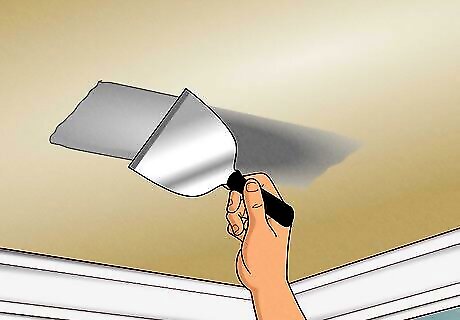
Apply a second coat of the mud. Use the same technique that you used for the first coat. Fully cover the mesh tape with the mud. This layer should cover up the tape’s grid pattern, so it won’t be visible after you’ve sanded and painted the ceiling. As with the first coat of mud, you’ll need to wait 30 minutes for this layer to fully dry. It should be dry in 5 minutes, but it’s best to give it extra time to ensure it is fully dry and ready for paint.
Finishing the Repair
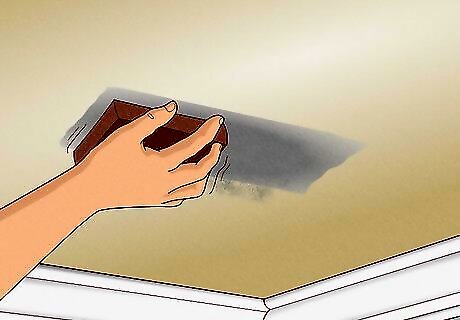
Sand the layers of mud with a sanding sponge. Now that the crack is structurally repaired, you’ll need to smooth out the rough patches. Take the sanding sponge and run it over the area you’ve covered with mud. Sand using a back-and-forth motion until the dried mud covering the former cracked area is smooth and flush with the rest of your ceiling. Sanding sponges can be purchased at your local hardware store. If they come in a range of grits, opt for a fine-grit sanding sponge. Depending on how much dried mud you sand off, it may make quite a mess. Try to ensure that the majority falls on the plastic sheet that you’ve laid down. If you still have fabric-covered furniture in the room, consider putting drop cloths over them to avoid permanent damage. If you are trying to match a very flat surface, mix the last coat of mud a little more watery than the first 2 coats and apply it to the ceiling with a 14 or 18 inch trowel. The longer trowel will fill in the low spots making a flatter surface.
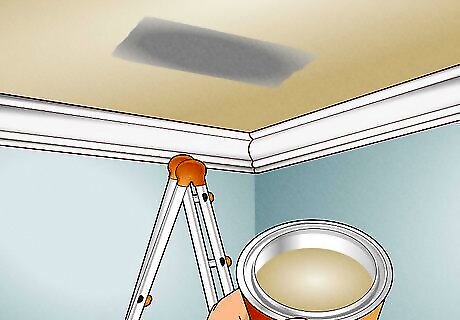
Find a paint color that matches your ceiling. The portion of ceiling that you’ve patched and sanded will need to be painted to match the rest of the ceiling. If you have some paint leftover from when you (or contractors) painted your ceiling initially, you can use this to paint over the repaired crack. If you don’t have leftover paint, you’ll need to visit a paint shop or home-supply store to find a matching coat of paint. Larger hardware stores may stock and mix paint, also. Pick up several paint-color strips, and compare each color against your ceiling to find the closest match. You can also bring a sample of the paint to your local home improvement center or paint store and have them match the color for you using a computer.
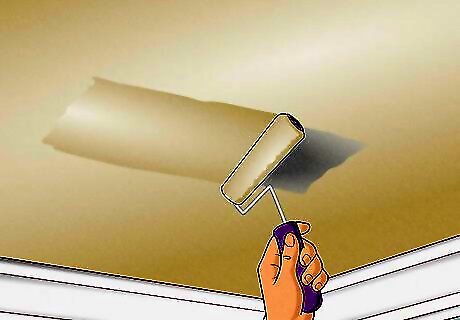
Paint the portion of the ceiling that you’ve sanded. Once you have your paint, pour about ½ cup (113 grams) into a metal painter’s tray. Roll your roller brush up and down through the paint until the entire surface of the brush is coated with paint. Then, working from one end of the patched crack to the other, use the brush to apply paint a layer of paint to your ceiling. After you’ve finished painting and the paint has dried, your ceiling should be a single color and texture.



















Comments
0 comment